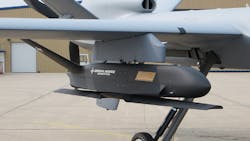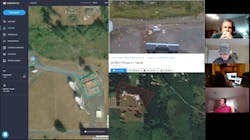Small UAS flight demonstrations conducted for battle management system drone
In this week’s roundup from the Association for Unmanned Vehicle Systems International, which highlights some of the latest news and headlines in unmanned vehicles and robotics, General Atomics tests a new launch-and-recover UAS, new traffic management for U.S. Air Force drone systems, and drones inspect critical communications infrastructure.
GA-ASI conducts captive carry Sparrowhawk sUAS flight demonstrations
From Sept. 16 to 17, General Atomics Aeronautical Systems Inc. (GA-ASI) conducted captive carry Sparrowhawk small UAS (sUAS) flight demonstrations.
Designed as an airborne launch and recovery demonstrator aircraft tailored to fit GA-ASI platforms, the Sparrowhawk aircraft focuses on Advanced Battle Management System’s attritableONE technologies.
To further airborne recovery of sUAS, Sparrowhawk iterates on the DARPA Gremlins Program, which reduces the cost of operation and enables new mission capabilities to GA-ASI’s MQ-9 Remotely Piloted Aircraft.
“Sparrowhawk extends and multiplies MQ-9-based sensors, reduces manpower and increases ISR coverage,” says GA-ASI President David R. Alexander.
“With attritableONE technology that is survivable and precise, Sparrowhawk is a true game changer.”
The Sparrowhawk sUAS was carried on a MQ-9A UAS. GA-ASI’s Metis Software Defined Control Station, which is hosted on a laptop computer, exclusively controlled the Sparrowhawk. According to GA-ASI, this drastically reduced the system’s logistical footprint and supports the vision for interfaces to the aircraft from across the battlefield — without the need for a Ground Control Station shelter or vehicle.
A fielded meshONE datalink helped achieve communications, enabling collaborative autonomy capabilities among the platforms. The Cooperation in Denied Environments (CODE) autonomy engine was implemented to further understand cognitive Artificial Intelligence (AI) processing for unmanned systems.
GA-ASI says that the test flights build on the capabilities demonstrated when Gray Eagle carried two Area-I Altius-600 Air Launched Effects (ALEs) during Multi-Domain Operations (MDO) demonstrations, which the company adds underscores its commitment to expanding the capabilities of its aircraft.
Sparrowhawk and airborne recovery enable a variety of benefits, including allowing below-the-weather ISR, and enabling reduced visual and acoustic ISR; enabling attritable ISR/EW in the contested environment, allowing the MQ-9 to stand off at safe ranges; employing larger and more expensive payloads at greater transit ranges compared to ground-launched aircraft and air-launched expendables; and maintaining the chain of custody, through adverse weather, MQ-9 rotations, or with multiple targets.
AirMap awarded contract to provide UTM service to USAF's Agility Prime program
AirMap has been awarded a contract to provide UAS traffic management (UTM) services to the United States Air Force’s (USAF) Agility Prime program.
In preparation for scaling of advanced air mobility operations, the USAF will use AirMap’s UTM platform to support testing of electric vertical takeoff and landing (eVTOL) aircraft.
“AirMap is proud to partner with the USAF to provide industry-leading UTM services for advanced air mobility operations,” says Larry Berkin, GM of the AirMap Defense Group, an AirMap business unit focused on providing mission-critical technologies to the US Department of Defense.
“We are excited to support all of the Agility Prime participants as they build, test, and bring their eVTOLs to market.”
A non-traditional program seeking to accelerate the commercial market for advanced air mobility vehicles, Agility Prime was launched recently by the USAF, who plans to mitigate current commercial market and regulatory risks by leveraging unique testing resources and government use cases for distributed logistics and disaster response.
The air vehicles tested throughout the program will be used for a variety of operations such as shuttling security forces across missile fields and search-and-rescue and logistics missions.
AFWERX awarded AirMap a $1 million Direct to Phase 2 Small Business Innovation Research (SBIR) contract to provide its UTM platform for Agility Prime.
Skyward granted waiver to conduct drone inspections near Big Hollow wildfire in Washington
Skyward, a Verizon company, has been awarded a temporary waiver from the FAA that allows its pilots to fly the Percepto Sparrow drone from their homes to inspect critical communications infrastructure near the Big Hollow wildfire in Washington.
The waiver permits operations 24 hours a day, with less than three miles of visibility, and no pilot or observer on site.
“At a moment when we are facing dangerous consequences of climate change and coping with a global pandemic, maintaining the Verizon Network has never been more important,” says Rima Qureshi, chief strategy officer, Verizon.
“Innovations in airborne technology have enhanced our ability to inspect our sites without putting engineers in harm’s way, and provide our first responders with reliable communications. We appreciate the FAA’s swift action in granting the waiver, which allows us to deploy a network-connected drone and provide critical services, safely and effectively.”
Skyward notes that while the FAA can grant beyond visual line of sight (BVLOS) waivers to businesses that prove they can fly safely, generally, an onsite pilot or visual observer has still been required.
Skyward spent nearly a year testing and proving it could safely fly without onsite personnel in preparation for crises such as the one occurring in the western U.S. The company says that the waiver itself is a milestone for remote deployment of drones in the U.S.
“We’ve built a BVLOS capability consisting of a remotely deployable drone system, weather monitoring systems like those used at airports, Skyward’s Aviation Management Platform, and state-of-the-art airborne safety systems that allow us to check the surrounding airspace for other aircraft,” says Skyward’s Director of Aviation Development Centers, whose name is X.
“Verizon’s 4G LTE network connected these systems, giving the team’s operations lead in Alaska a near real-time picture of the operation from 1,600 miles away.”
Granted through the FAA’s expedited Special Governmental Interest process, the waiver applies to drone support operations for critical infrastructure that maintain communications for emergency responders and extended until Friday, Sept. 25.
Over a two week stretch in September, the Big Hollow Fire burned more than 24,000 acres and caused mandatory evacuation orders in the area. The location of the critical communications infrastructure itself is within blocks of a Level 1 evacuation order and the air quality was unsafe for humans. Skyward says that this operation allowed Verizon engineers to confirm the integrity and operability of its infrastructure was not impacted, all while keeping people out of harm’s way.
Compiled by Brian Sprowl, Associate Editor, AUVSI
Share your vision-related news by contacting Dennis Scimeca, Associate Editor, Vision Systems Design
SUBSCRIBE TO OUR NEWSLETTERS

